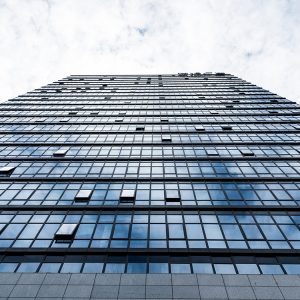Modern curtain wall features in commercial buildings
Curtain walls today are typically aluminum frames infilled with cladding of glazing, metal, or stone. Connected to a building’s floors or columns, they don’t carry the structure but do serve to help keep out air and water, reduce sway, and transfer wind and gravity loads to keep the structure stable. In practical applications, in spite of the higher curtain wall costs than the traditional materials in building projects, modern curtain wall design do provide many benefits to buildings.

As a rule, curtain wall material selection not only depends on appearance, but also depends on several properties like thermal efficiency, insulation (air, moisture, sound), and fire resistance. Nevertheless, in most cases, curtain wall systems are not more than just a pretty face of the modern buildings today. In other words, curtain wall facades both set the tone for a building and play important engineering roles in the modern curtain wall construction. For example, in the modern times, commercial curtain walls are now the hallmark of contemporary city skylines, used to achieve a host of purposes, like energy-efficiency, transparency, designing flexibility and so on. And the most notable advantage of commercial curtain walls is their pretty beautiful appearance in applications. In particular, aluminium curtain wall offers a sophisticated look, which significantly enhances its visual attractions in some large famous commercial buildings around the world today. In most cases, commercial curtain walls can be double-glazed or treated, enhancing insulation. Once enveloping a building with curtain walls, the heat is kept outside during summer and inside during winter. As for glass curtain wall, it is possible for natural light to enter into buildings. And transparent/translucent glass helps maximize the usage of natural light, always a key consideration in any architectural design. For example, natural light instantly makes space appear larger and livelier. People enjoy wall-to-wall views.
In the current market, unitized curtain walls and stick-built curtain walls are the two major popular types of curtain walls in use. Specifically speaking, unitized curtain walls are factory-assembled frames, which can reduce installation time and cost but have a higher cost for shipping and storage and may need to be pre-ordered well in advance, causing potential delays. And for stick-built curtain walls tend to take much longer time to install on site and lack the type of quality control a factory offers. But the stick system can still be best overall for smaller, low-rise structures, and in fact makes up about a quarter of the market. Nowadays, sustainability is becoming a hot trend in the modern curtain wall construction industry. A couple of curtain wall manufacturers are trying to combine the benefits of standardised production with some degree of customisation.
Tel: +86 18202256900 Email: steel@tjdpbd.com









